前回の記事では、抗がん剤治療中の血液がん患者さんに、低強度運動のがんリハビリテーションを行うことが効果があることを紹介しました。
低強度での運動は行いやすいんですが、それすらもなかなか体調が悪くて行えない方も多いですよね。
強度は低強度でもいいとして、頻度や回数はどれくらい行うのがいいのでしょうか?
そこで今回は、低強度運動をどれくらいの頻度を行った方が効果があるのかを検証した論文を紹介します。
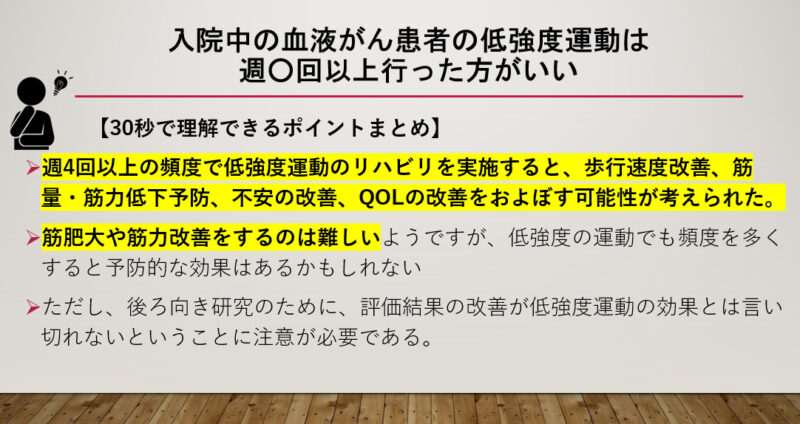
今回紹介する研究の概要
今回紹介する論文は、入院して抗がん剤治療を実施している血液がん患者さんが、低強度運動のがんリハビリテーションを高頻度に実施することの効果を検証している内容です。
「Fukushima T, Nakano J, Ishii S, et al. Low-intensity exercise therapy with high frequency improves physical function and mental and physical symptoms in patients with haematological malignancies undergoing chemotherapy. Eur J Cancer Care (Engl). 2018 Nov;27(6):e12922. doi: 10.1111/ecc.12922. 」2018年に発行された論文です。
お家で簡単エクササイズ ポンポンキューブ対象
The inclusion criteria were as follows: (a) inpatients diagnosed with a haematological malignancy, (b) hospitalisation for chemotherapeutic treatment, (c) prescription for rehabilitation, (d) age >20 years, (e) patients who understood the evaluation content of muscle and physical function, and activities of daily living (ADLs) and did not show rejection, and (f) those who could fill questionnaires by themselves. The exclusion criteria were as follows: (a) communication difficulties, (b) poor general health status, (c) severe heart disease, (d) severe respiratory disease, (e) hepatic or renal failure, and (f) cerebrovascular or orthopaedic diseases that could influence muscle and physical function.
Fukushima T, Nakano J, Ishii S, et al. Low-intensity exercise therapy with high frequency improves physical function and mental and physical symptoms in patients with haematological malignancies undergoing chemotherapy. Eur J Cancer Care (Engl). 2018 Nov;27(6):e12922. doi: 10.1111/ecc.12922.
対象は、入院してを抗がん剤治療を実施している血液がん患者さんのうち、リハビリテーションの処方がでた方となっています。
合併症や病状の影響で、コミュニケーションや運動機能に問題がある方は除外されています。
抗がん剤治療はしているけど、ある程度ご自分で動けるし、理解力もある方が対象のイメージですね。
薬剤師が厳選した原料で開発した自信作!「からだ楽痩茶」方法
運動療法
All participants performed LIET from the initiation of rehabilitation until their discharge on weekdays. Based on the report of Furzer et al. (2016), we adopted a mixed‐exercise programme consisting of re‐ sistance training and aerobic exercise. LIET was set at 20 to 40 min, once a day, for up to five times per week. This programme promoted as much walking as possible, up and down the stairs, in one to two sets. Resistance training comprised of the following: one set of 10–20 flexion and extension exercises of the hip, knee and elbow joints, fol‐ lowed by the addition of 0–2 kg weight loads for one to two sets, 5–20 times standing up or calf raises for one to two sets and five squats as one set. The ergometer was set at low load for 5–10 min, which comprised the aerobic exercise. These programmes were carried out one set per day. Davis and Convertino (1975) reported that the Karvonen formula was a reasonably accurate method for estimating exercise intensity and that a low‐intensity exercise was defined as an exercise with 40% or less heart rate reserve. The ex‐ ercise intensity was set at 40% or less of the predicted maximum heart rate calculated by the Karvonen formula and set to “somewhat hard” rated as “4” on the modified Borg scale (Borg, 1982). As a gen‐ eral rule, LIET was performed on weekdays.
Fukushima T, Nakano J, Ishii S, et al. Low-intensity exercise therapy with high frequency improves physical function and mental and physical symptoms in patients with haematological malignancies undergoing chemotherapy. Eur J Cancer Care (Engl). 2018 Nov;27(6):e12922. doi: 10.1111/ecc.12922.
介入方法としては、低強度の運動療法を平日に5日/週の頻度で実施しています。
運動内容としては、軽い重錘負荷での上下肢の筋トレ、スクワット、カーフレイズ(つま先立ち)、歩行、自転車エルゴメーターを組み合わせた運動を20分間実施しています。
運動強度は、修正ボルグスケールの「4,ややきつい」を目安に、カルボーネン法により算出した上限心拍数の40%以下で行っております。
修正ボルグスケールやカルボーネン法というのは運動強度の評価の一つです。詳しく知りたい方はコチラ。
心拍数からの評価では40%は低強度に分類されます。
運動内容も軽い負荷での運動で、回数・セット数も比較的少ないようですね。
抗がん剤治療でも行いやすい負荷の運動を実施しておりますが、体調が悪いときなどはリハビリをお休みする場合もあるようです。
筋トレ×キックボクシングx有酸素トレーニング【WHOEVER】評価項目
We evaluated the participants’ muscle and physical functions, ADLs, psychological distress and QOL at the start of rehabilitation (base‐ line) and at discharge (post‐treatment). Baseline age, sex, body mass index (BMI), cancer type, blood biochemical parameters (haemoglo‐ bin, C‐reactive protein, albumin, total protein, lymphocytes), days since hospitalisation, days since chemotherapy and disease duration data were collected from the medical records. The length of hospital stay was recorded upon discharge.
Fukushima T, Nakano J, Ishii S, et al. Low-intensity exercise therapy with high frequency improves physical function and mental and physical symptoms in patients with haematological malignancies undergoing chemotherapy. Eur J Cancer Care (Engl). 2018 Nov;27(6):e12922. doi: 10.1111/ecc.12922.
- 握力
- 膝伸展筋力
- 大腿直筋筋厚
- 歩行速度
- 動的バランス:Time Up and Go test
- ADL能力(日常生活動作能力)
- 全身状態:Eastern Cooperative Oncology Group(ECOG)の Performance Status(PS)
- 不安・抑うつ:Hospital Anxiety and Depression Scale(HADS)
- QOL(生活の質):EORTC QLQ-C30
大腿直筋筋厚とは、太ももの前面の筋肉の厚みのことです。内科などで検査するようなエコーを使用して、厚みを測定しています。筋肉がやせ細っていないかの検査ということですね。
Time Up and Go testとは、椅子から立ち上がって、3m先のコーンを回って椅子に戻ってきて座るまでの時間を測定する検査です。起立-歩行-方向転換などの動的バランスを評価する検査となります。
ADLとはActivity Daily Livingの略で、日常生活がどの程度自立しているかの評価です。点数が高いほど、日常生活が自立、つまり他人の手を借りなくても大丈夫という意味になります。
Eastern Cooperative Oncology Group(ECOG)の Performance Status(PS)というのは、0~4点の5段階で全身状態を評価する指標です。簡単に言うと0だと問題なしで、点数が高くなるにつれて日中に動けなかったりベッドに寝ていることが多くなってきて、4だと終日寝たきりになっているような感じです。がん患者さんの全身状態の簡便な評価としてよく用いられますね。
不安・抑うつというのは精神症状の一つですね。HADSという質問紙に自己記入してもらう形の評価で、点数が高くなるほど症状が強いということになります。
QOLとはQuality Of Lifeの略で、生活の質と訳されます。運動機能の改善だけでなく、生活の満足度がどれくらい上がったかというのも、リハビリの効果として重要な指標となりますね。EORTC QLQ-C30という質問紙を使用して評価しています。
Xserverドメイン解析方法
Participants were divided into two groups based on the LIET inter‐ vention frequency. LIET was generally performed on weekdays. The intervention was omitted in the case of poor general health status and strong patient refusal. Accordingly, some patients performed LIET at a high intervention frequency (about five times per week), whereas some patients performed LIET at a lower intervention fre‐ quency. Upon hospital discharge, the median intervention frequency was calculated retrospectively and was used as the criteria for the division of patients into two groups according to the previous study (Morishita et al., 2013). The two groups consisted of a high‐fre‐ quency group (HF; intervention frequency greater than the median) and a low‐frequency (LF; intervention frequency less than the me‐ dian) group. Statistical analysis was performed using IBM SPSS Statistics version 23 software (IBM Corp., Armonk, NY, USA). Data were pre‐ sented as mean ± standard deviation (SD), and missing values were excluded from the analysis. The comparison of demographic and clin‐ ical characteristic data was performed using the Mann–Whitney U test and the chi‐square test. Two‐way repeated‐measures analysis of variance (ANOVA) was performed to compare the effects between the two groups (HF and LF), time (baseline and post‐treatment) and interaction between the group and time. Values of p < 0.05 were considered statistically significant.
Fukushima T, Nakano J, Ishii S, et al. Low-intensity exercise therapy with high frequency improves physical function and mental and physical symptoms in patients with haematological malignancies undergoing chemotherapy. Eur J Cancer Care (Engl). 2018 Nov;27(6):e12922. doi: 10.1111/ecc.12922.
基本的にリハビリを平日に週5回行うことになりますが、体調不良等でリハビリが実施できない場合もあります。
そこで、リハビリ実施頻度を計算して、その中央値で2群に群分けしています。簡単にいうと、リハビリを行うのが多かった群と少なかった群で分けて解析したということです。
2群のリハビリ開始時と退院時の評価の結果の推移を解析しています。
24時間ボディメイク【マッスルプレス】結果
Fukushima T, Nakano J, Ishii S, et al. Low-intensity exercise therapy with high frequency improves physical function and mental and physical symptoms in patients with haematological malignancies undergoing chemotherapy. Eur J Cancer Care (Engl). 2018 Nov;27(6):e12922. doi: 10.1111/ecc.12922.
44名の患者さんが解析対象となり、リハビリ実施頻度の中央値で2群に分けられました。
リハビリ実施頻度は、週5日間実施できると100%として、中央値が82%となっていました。
82%以上実施できた22名をHF群、82%未満しか実施できなかった22名をLF群と群分けしています。
平均年齢は68.2歳で、平均在院日数は40.5日となっております。
自宅で快適なトレーニングをするなら!【NUOBELL】Fukushima T, Nakano J, Ishii S, et al. Low-intensity exercise therapy with high frequency improves physical function and mental and physical symptoms in patients with haematological malignancies undergoing chemotherapy. Eur J Cancer Care (Engl). 2018 Nov;27(6):e12922. doi: 10.1111/ecc.12922.
こちらの表は、運動機能や日常生活動作の推移となります。
ECOG PSやFIMといった全身状態や日常生活動作は、2群とも改善しております。
運動機能としては、HF群のみ歩行速度の向上が認められています。
さらには、LF群は膝伸展筋力と大腿直筋筋厚は低下傾向であるのに対して、HF群は筋力や筋厚が維持できています。
日常生活を自立するくらいであれば低頻度のリハビリでも効果があるみたいですが、歩行速度を改善させたり、筋肉量や筋力を維持させたりするような運動機能に対しては、高頻度のリハビリが必要なようですね。
今話題のエクオール「女性特有の悩みゆらぎをサポート」キレイ・デ・エクオールFukushima T, Nakano J, Ishii S, et al. Low-intensity exercise therapy with high frequency improves physical function and mental and physical symptoms in patients with haematological malignancies undergoing chemotherapy. Eur J Cancer Care (Engl). 2018 Nov;27(6):e12922. doi: 10.1111/ecc.12922.
こちらの表は、不安・抑うつの推移となります。
HF群の方が、不安の点数が減少しており、すなわち不安の症状が改善しています。
[ヨガ・フィットネス]欲しいウェア必ず見つかる♪【Puravida!】Fukushima T, Nakano J, Ishii S, et al. Low-intensity exercise therapy with high frequency improves physical function and mental and physical symptoms in patients with haematological malignancies undergoing chemotherapy. Eur J Cancer Care (Engl). 2018 Nov;27(6):e12922. doi: 10.1111/ecc.12922.
こちらの表は、QOLの推移となります。
症状としてはHF群のみが不眠、痛み、倦怠感が改善しています。
さらに、HF群のみが身体面のQOL、精神面のQOL、そして、全体のQOLが改善しています。
高頻度のリハビリを行うことで、QOLの改善も認められていますね。
休息サポートサプリメント【スヤナイトα】結論
Low‐intensity exercise therapy could be a potential treatment strategy for patients with haematological malignancies undergoing chemotherapy who are unable to per‐ form mid‐ or high‐intensity exercise.
Fukushima T, Nakano J, Ishii S, et al. Low-intensity exercise therapy with high frequency improves physical function and mental and physical symptoms in patients with haematological malignancies undergoing chemotherapy. Eur J Cancer Care (Engl). 2018 Nov;27(6):e12922. doi: 10.1111/ecc.12922.
今回の研究結果では、抗がん剤治療で入院中の血液がん患者さんに対して、中~高頻度のリハビリを行うことが、歩行速度改善、筋量・筋力低下予防、不安の改善、QOLの改善をおよぼす可能性が考えられました。
低強度の運動なので、筋肥大や筋力改善をするのは難しいようですが、低強度の運動でも頻度を多くすると予防的な効果はあるかもしれないですね。
筋トレの運動強度については以前にまとめていますので、興味があることはコチラをご覧ください。
今回の研究からは、低強度の運動であれば80%くらいの頻度、つまり、週4回以上の運動が推奨されることになりますね。
研究の限界としては、症例数が少ないことが挙げられています。
そして、後ろ向き研究のために、評価結果の改善が低強度運動の効果とは言い切れないということが挙げられています。
例えば2年間多くの患者さんのリハビリを実施していて、その効果を知りたいから、調査してみようというのが、今回のような後ろ向き研究です。
それに対して、リハビリの効果を知りたいから、今から患者さんをどのように群分けして、どのような項目を調査しようと計画するのが、前向き研究になります。
その群分けを無作為に行うのが、他の因子の影響を受けにくいランダム化比較試験となります。
今回は、後ろ向き研究のため、評価結果が改善した理由はほかの因子の影響があるかもしれないということですね。
しかし、リハビリの実施頻度で群分けして、その効果が認められたのは非常に素晴らしいと思います。
がん患者さんでも行いやすい低強度のリハビリの効果が徐々に認められていることは非常に参考になりますね。
抗がん剤治療中は、軽めの運動でもいいので、できるだけ継続することがいいようですよ。週5回の82%の実施率なので、概ね週4回は運動したほうがいいみたいですね。
【アイリスオーヤマ公式】アイリスプラザ・筋肥大や筋力改善をするのは難しいようですが、低強度の運動でも頻度を多くすると予防的な効果はあるかもしれない。
・ただし、後ろ向き研究のために、評価結果の改善が低強度運動の効果とは言い切れないということに注意が必要である。
このブログは、ガイドラインや論文などの根拠をもとに情報を発信していく予定です。
しかし、がんの病態や治療方法によっては、お読みになっているがん患者さんにはその情報が当てはまらない場合もあります。
記事の内容を参考に新しく何かを始める場合には、担当の医師や医療従事者にご確認いただくようお願いいたします。


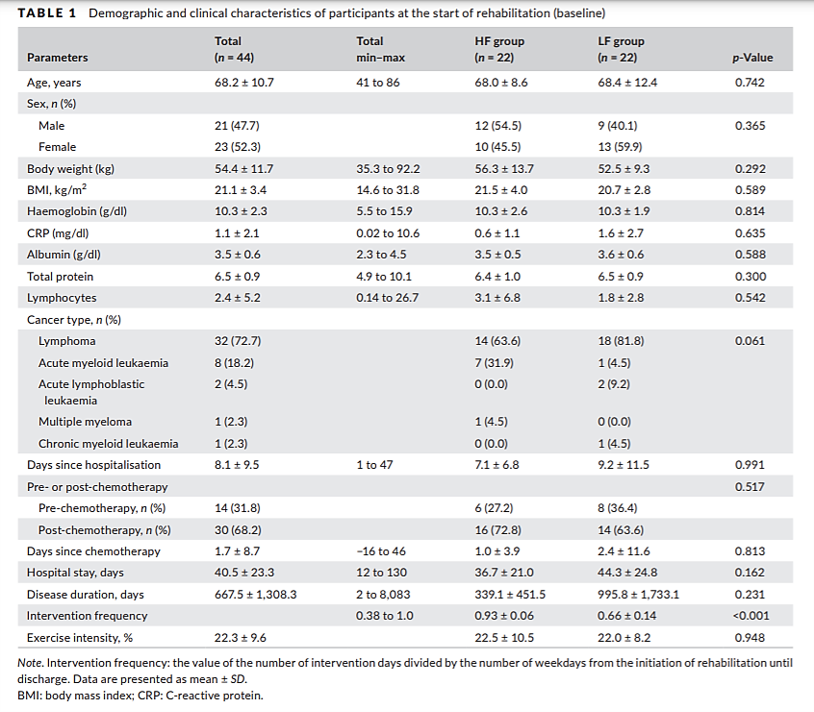




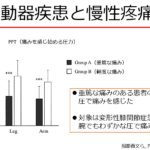
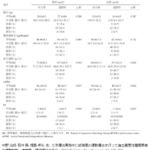

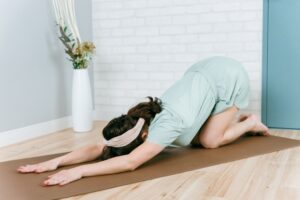

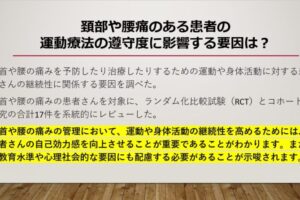
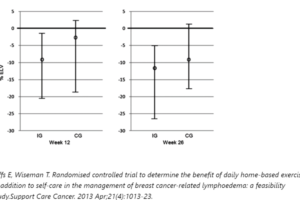












最近のコメント